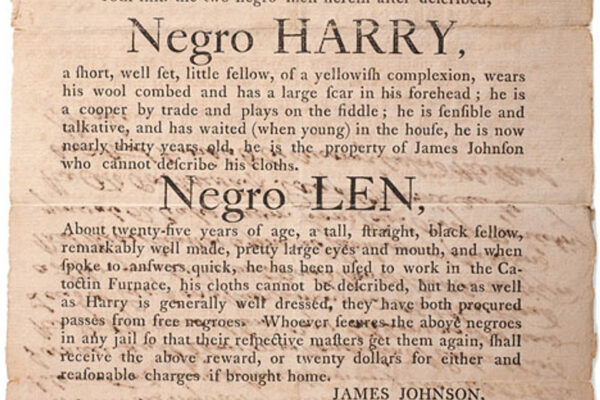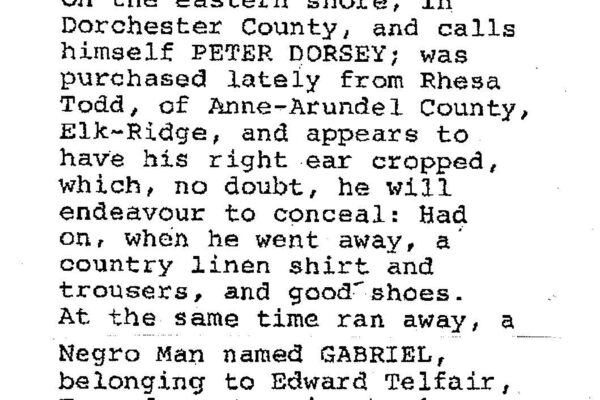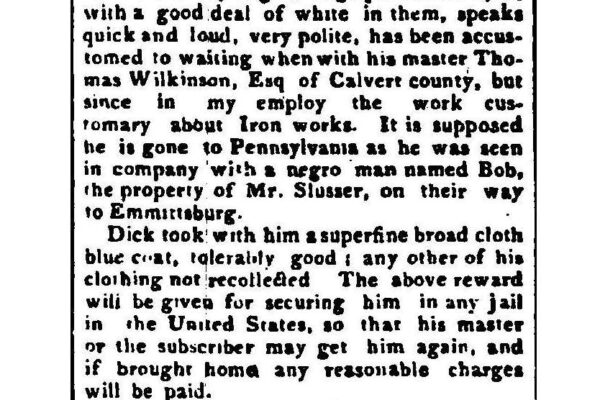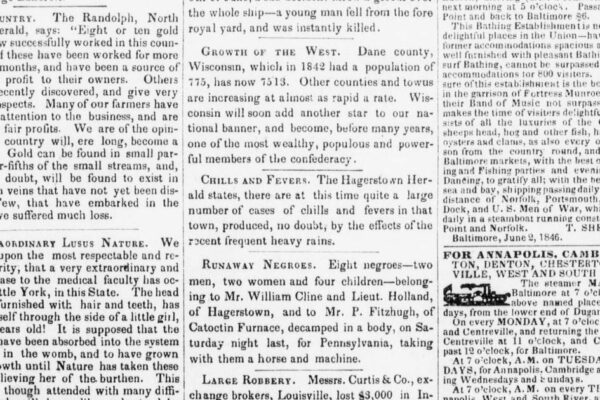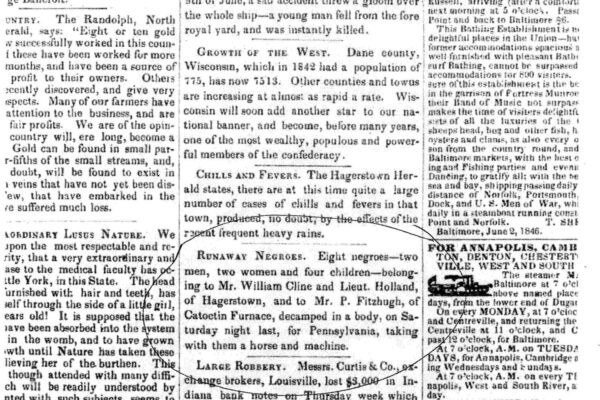The Catoctin Furnace Historical Society, Inc., celebrates, studies, and preserves the rich history of this pre-revolutionary industrial village, including the architecture, cultural landscapes, lifeways, and foodways of the workers. Below you will find some useful documents and links to historical and scientific research.
Historic Paint Finishes Study
Recently, two paint samples were analyzed from the interior of the Forgeman’s House. Click here to download the report.
Historical and Archaeological Reports
- Restoring Identity to People and Place: Reanalysis of Human Skeletal Remains from a Cemetery at Catoctin Furnace, Maryland
- Contract Archaeology, Inc. 1971. An Historical and Archaeological Survey of Land Affected by the Dualization of U.S. Route 15 at the Catoctin Iron Furnace. Prepared for State of Maryland State Highway Administration, Baltimore, Maryland. (Part 1, Part 2)
- Eleanor Lakin Architects. 1987. Collier’s Log House Specifications. Prepared for the Catoctin Furnace Historical Society. (Part 1, Part 2, Phase 2)
- Fauth, John L. 1978. Report on the 1970 and 1977 Borings taken by the Maryland Department of Transportation State Highway Admininstration in the Catoctin Furnace Area. Prepared for Orr and Son Consulting Archaeologists. (Download)
- Parrington, Michael and Helen Schenck. 1982. A Report on the excavation of an ancilary area (Site 18FR320) of the historic ironworking complex at Catoctin Furnace, Frederick County, Maryland. (Sections I-IV, Sections V-VI, Section VII, Bibliography/Figures/Plates, Appendices I and II, Appendix III)
- National Heritage Corporation. 1975. Catoctin Iron Furnace Cunningham Falls State Park, Thurmont, Maryland: A Report on an Historical Survey. Prepared for the State of Maryland Department of Natural Resources, Land Planning Services. (Part 1, Part 2, Part 3)
- Orr, Kenneth and Ronald Orr. 1977. An Intensive Archaeological Survey of Alignment 1 Corridor, U.S. Route 15 from Putnam Road to Maryland Route 77 in Frederick County, Maryland. (Part 1, Part 2)
- Reed, Douglass. 1981. Catoctin Furnace Iron Master’s House. A Cultural Analysis of the Structure: An Ideal Expressed. Prepared for Professor John Vlach, Foklife Studies, American Studies Program, George Washington University. (Download)
- Reed, Douglass and Paula Dickey. 1977. Catoctin Furnace Double Log House: A Historic Structure Report. Prepared for the Catoctin Furnace Historical Society. (Download)
- Reed, Douglass and Paula Reed. 1985. A Report Concerning the Construction History of the Stone Retaining Walls and Furnace Stack. Prepared for the State of Maryland Department of Natural Resources, Capital Programs Administration. (Download)
- Struthers, Thomas. 1981. Archaeological Survey of Catoctin Furnace, Cunningham Falls State Park and Adjacent Areas. Prepared for State of Maryland Department of General Services and Department of Natural Resources. (Part 1, Part 2)
The following links are provided through the Jefferson Patterson Park website:
- Burnston, Sharon Ann and Ronald A. Thomas. 1981. Archaeological Data Recovery at Catoctin Furnace Cemetery, Frederick County, Maryland. Prepared for Orr and Son, Consulting Archaeologists.
- Burnston, Sharon Ann and Ronald A. Thomas. 1981. Archaeological Data Recovery at Catoctin Furnace Cemetery, Frederick County, Maryland: Appendices. Prepared for Orr and Son, Consulting Archaeologists
- Fauth, Dr. John L. 1980. The Catoctin Furnace Archaeological Mitigation Project. U.S. Route 15, Putnam Road to Route 77, Frederick County, Maryland: Report by the Geological Consultant.
- Orr, Kenneth and Ronald Orr. 1980. Interim Report of the Catoctin Furnace Archaeological Mitigation Project Contract F522-152-770. Prepared for the Maryland State Highway Administration.
- Orr, Kenneth and Ronald Orr. 1982. The Catoctin Furnace Archaeological Mitigation Project: Final Report of the 1979 Excavation Contract F522-152-770. Part 1: Investigations and Site Synthesis (Consultant’s Team). Prepared for the Maryland State Highway Administration.
Payrolls and Ledgers
Historic payrolls for Catoctin Furnace may be download below:
- Feb 1882 Catoctin Furnace Pay Roll and Store Ledger, Part 1
- Feb 1882 Catoctin Furnace Pay Roll and Store Ledger, Part 2
- Oct 1863 Catoctin Furnace Pay Roll and Store Ledger
- May 1864 Catoctin Furnace Pay Roll and Store Ledger
- Jan 1886 Catoctin Furnace Pay Roll and Store Ledger
- 1899-1901 Catoctin Furnace Upper Mine Bank Payroll Ledger (230MB)
- Pay Roll Column Explanation
- Pay Roll
The Catoctin Furnace Historical Society, Inc. has a copy of the Upper Mine Branch Ledger from 1899 to 1901 at the Collier’s Log House. The Ledger lists each person by name, days worked, pay rate, and total wages paid. It subtracts merchandise at the company store, rent paid, and wood purchased. At the end of the month, many received no pay. The names will be familiar to all village families as well as many in the Thurmont area.
Oral Histories
Oral History Transcripts: interviews with residents of Catoctin Furnace. Please note that in order to listen to the audio files of the oral histories you will need an MP3 player such as Winamp, RealPlayer, or Windows Media Player)
Dr. Mark Howell
Dr. Mark Howell brings forth a lecture titled “Forging a Partnership: The Iron Industry in Frederick and Washington Counties” in 1998. This lecture provides the background for the interviews below. Dr. Howell explains the origins of not only the buildings that made up each furnace, but also the different people that built the furnaces, what the furnaces produced, and their legacies.
*Please note that some of the lecture throughout and much of the end is extremely hard to hear as Dr. Howell stepped away from the microphone and his words were not deciphered.
Barney and Clara Carbaugh
Barney and Clara Carbaugh discuss their childhood which includes how Barney viewed the furnace that surrounded his life. He tells the story of his family; how his grandmother provided for her children after her husband died during war. He tells how he joined his father in work after his father learned a plethora of skills in the various jobs he worked. Barney describes his childhood shenanigans with Mutt and the girls while working with mules during the operation of the paint mill. Meanwhile, Clara describes a secret hideout in the mountains that everyone desperately tried to discover. The pair go on to discuss the geography of where they grew up, how locations came into being and they were subsequently named.
Ethel Devilbliss
This interview discusses very thoroughly a menu of meals that Ethel prepared and ate growing up some of which she continued to make once she had her own family. Many dishes are described in great detail, such as the bread her father taught her to make, how they grew their own yeast and the different dishes she made with the bread. Almost everything her family ate, they raised themselves and she describes using the farmer’s almanac and confirms Bill and Boot’s same faith in the effects of the moon phases. Ethel recalls how her father died when she was young and how her mother worked off of the farm cleaning houses in addition to selling some fruit they grew in order to support her nine children. Being poor it was very rare that the family ate meat but Ethel describes how her mother prepared rabbit when the boys hunted it during the appropriate season and how they used the many different parts of a pig if they had one. Otherwise the family was very resourceful in order to never go hungry, if nothing else eating shortbread and gravy made from browned bread and “meat drippings”. Discussed in brief is the Devilbiss house that had been in Ethel’s husbands family for at least 150 years.
Mabel Fraley and Jessie Stitely
Mabel Fraley, who lived in the Manor House when she was young, describes the layout of the house and how it operated such as the functions of the rooms, the dumb waiter, how it was heated by fireplaces. Jessie Stitely adds her own details about the aesthetics of the house such as the painted walls and carved wood. They both recount the names of the other tenants who lived in the house, the Carrs, the McDaniel’s, Bill Renner, and how differently the house was run under each. Old photos are discussed in length for the majority of the interview. Mabel, Jessie, and Elizabeth attempt to identify the buildings and roads in the pictures, clarifying when and for what they were used. A few structures mentioned are the steel mill, the furnace, the stable, the trolley station, Catoctin Hollow Road, stave mill, and the store which Mabel’s father builds after he has to vacate and shut down the post office. Discussed in detail is the old stone church and the different religious leaders that headed it included Father Damuth, Reverend McGill, Dr. Treder, and Reverend Wolfe. Mentioned several times, throughout the interview, are laments about either the loss or lack of historical records.
Plummer Fraley
In this interview Plummer Fraley discusses life with his father and friends. He talks about the furnace he grew up around and watched as the charcoal would light up in the sky like fireworks. The mines that ran around the furnace provided work for his brothers while him and his father tended the farm. Later on he discussed how the furnace changed hands numerous times while the mountain was the source of work and charcoal for the surrounding towns. He discusses how him and his friends walked around the neighborhood traveling to nearby towns in search of a party. He finishes the interview talking about the fire that almost ended Creagerstown when he was a boy.
Hoke and Miller Family
The interview that took place in November of 1981 is split into two parts, A and B. Part A is then split into two separate interviews, one with the Hoke family that ends around minute 27 and the interview with the Miller family that finishes up the file.
The first half of the interview is done with Lloyd and Patsy Hoke. The two discuss their genealogical lineage in which they tell about their father and grandfather who used to work up in Pennsylvania before moving to Maryland. The go on to discuss the various buildings that dotted the area during their childhood and how each building had to be whitewashed to look clean. The latter half of the interview discuss slaves and the boarding house.
The second half of the interview takes place with Clinton Miller. He discusses, similar to the Hokes, the various buildings that lined the area and how they came to be. He also discusses the few people that may have been slaves in the area. Finally, he talks about the Manor House and what he used to do for entertainment as a child.
Hoke and Miller Family Part 2
In the second part of the interview with the Hoke and Miller families Clinton Miller and Patsy Hoke discuss their childhood. The pair discuss parties they attended and what church life was like. Afterwards, they discuss the people that traveled from Pennsylvania to the furnaces in Maryland. what buildings they could work at, and how those buildings were operated. Finally the pair recall what their childhood homes looked liked including the floorboards, pillows, and the great old time of underwear.
*the audio that goes with this interview last about 26 minutes despite the CD going for 46 minutes*
Clinton Miller
The interview with Clinton Miller touches the simple life he had during his childhood. Clinton reflects on the people he used to live around and how the houses looked from the inside. He talks about his job and the trolley that ran through near his town. He talks about his family, their diet, how their housed looked, fun parties he attended with his friends, and the ice cream they used to make during the summer. Lastly, he discusses how holidays were back in his childhood, some similar to our now-a-days, while others you wouldn’t be able to recognize.
Bill Renner
The first part of this two part interview (both parts are found within the same transcription PDF) share stories told by Bill Renner. He begins by telling Elizabeth about the furnace and his old job, describing what he did and his injury during a shift. He goes on to describe his childhood, sitting out on the porch watching the fireworks, as he calls them, the furnace released. He describes the area as it looked in his childhood then goes on to explain land deals, exchanges, married life, stores, and the people he came across and befriended. Elizabeth and Bill discuss slaves and their graves that were in the area followed by Bill discussing some of the older buildings that used to be in the area. He talks about the various railroads and what was mined in the area. He then finally talks about the people that lived in the area when he was growing up and how people interacted with one another. (Part 1 ends here)
Bill Renner Part 2
The second part begins by discussing the possibly of gathering artifacts and putting together a museum. Bill then goes on to discuss his genealogy and his various jobs he held such as working on the trolley. The two discuss Bill’s family history from Ireland and Germany (and subsequently a large amount of money that was never collected). Bill goes on to describe the Conkel Furnace and the “coloured” families that lived in the area including their church. He then explains the geography of the area, including Locust Pond, and the people that dot the land. The interview cuts off with Bill talking about his mother’s jobs and the locations of the various furnaces that were in the area.
Bill and Boots Sweeney
Bill and Boots recall their way of life as it used to be and how things have changed in the present day. They mostly discuss growing, harvesting, and preparing their own food. The conversation begins by describing processes such as making meat pudding, canning corn and tomatoes, and raising hogs, chicken, and cows. It is mentioned that specific jobs were divided between men and women but throughout the text it is apparent that generally both genders participated in preparing meals. The farmer’s almanac is also brought up and the guidelines on planting crops are discussed in detail; Bill and Boots are very specific about the phases of the moon, zodiac signs and using the right type of fertilizer. Next there is talk of collecting wild greens and growing herbs for tea. It seems such things are not available or do not grow in abundance the way they used to do. In the context of how the land has been built up over the years it is briefly mentioned that the Sweeney house, built in 1863, is very valuable. Then the discussion turns back to comparing older times to present times, how older generations seemed to be more self-reliant, and the quality, as well as the expenses of food bought from stores or restaurants are contrasted with farming and self-preparation.
Interviews on the News
Interview with Elizabeth Comer about the history of Catoctin Furnace and Spring in the Village: When Maryland Made Iron: Exploring the Furnace of Catoctin. First heard on Maryland Morning, WYPR 88.1 FM, May 7, 2013.
Interview with Elizabeth Comer about Catoctin Furnace history and people. First heard on To the Point, WTHU 1450 AM, April 27, 2013.
LiDAR Analysis
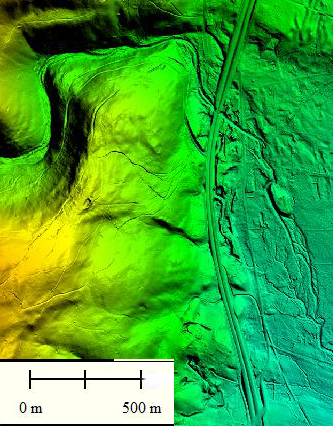
The Catoctin Furnace Historical Society has acquired LiDAR (Light Detection And Ranging) imagery for the area, and we are currently analyzing the data. LiDAR is a remote sensing technology whereby a target surface is measured by illuminating it with a laser and analyzing the reflected light, producing highly accurate maps of surfaces. With these maps, we can locate archaeological features over an expansive landscape that might not otherwise be visible. To the left is an image of the Catoctin Furnace area with highly visible roads (Catoctin Furnace Road and Route 15) and buildings.
Below is an image of “colliers pits” that were located using the LiDAR imagery. Such pits were used to produce charcoal to feed the furnace. Mounds of wood were carefully stacked and set into a pit, then ignited. Colliers would need to monitor the fire to ensure that it did not grow too big or go out.
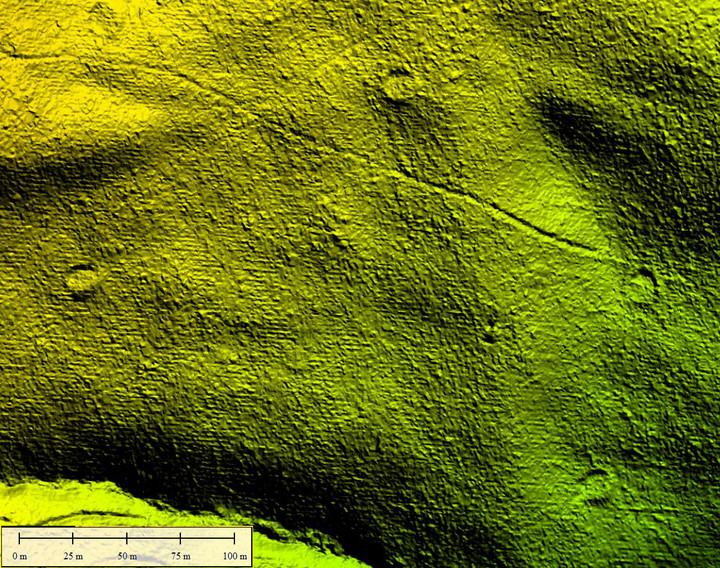
XRF Research
Representatives from EAC/A, Inc. attended a workshop at the Smithsonian in Washington D.C. to learn how to use a handheld XRF (X-Ray Fluorescence) to determine the elemental composition of archaeological materials. We used materials from Catoctin Furnace to test our skills. The preliminary results of our research are here: XRF Results for Catoctin Furnace materials.
UPDATE: Using a Bruker Tracer, we have completed testing on samples from Catoctin Furnace, Gettysburg, and Cornwall. We are analyzing the results now and will update this information soon!
Freedom Seeker Ads
At least 16 enslaved persons sought their freedom from their owners at Catoctin Furnace, undoubtedly there were many more. The language of freedom seeker ads is testament to the uniqueness and humanity of the people described. They are also chilling in the description of human beings as property.
Harry and Len left on the 18th day of October, 1802 with passes they received from free African Americans. Harry played the fiddle, was trained as a waiter, and described as sensible and talkative. Len was described as remarkably well made with pretty, large eyes and mouth. The reward of $40.00 offered for their return was the equivalent of more than a thousand dollars today.
The men, women and children who sought their freedom from Catoctin Furnace risked everything to escape the horrific and violent bondage of slavery. These ads bear witness to their astounding bravery. Shifting and centering the narrative of slavery at Catoctin is a work in progress, one that requires facilitating a dialogue and creating opportunities to educate audiences in a way that invites a visceral connection to the reality of this history and the human beings who lived it. With a deeper collective level of understanding of the effect of centuries of enslavement on the present struggle for racial justice, equity, and inclusion, it is hoped that a new framework for reparative heritage will be possible at Catoctin Furnace and beyond. Ultimately, it is hoped that the resultant action we take to build the future we claim to believe in, as individuals, communities, institutions, and a nation that claims to fight for freedom, will be facilitated by programs such as those undertaken at Catoctin Furnace. The search for freedom continues today. Freedom from the legacy of enslavement and intergenerational racism. When? was the question asked at Catoctin Furnace by freedom seekers. When? is still the question asked today by millions of black Americans.

